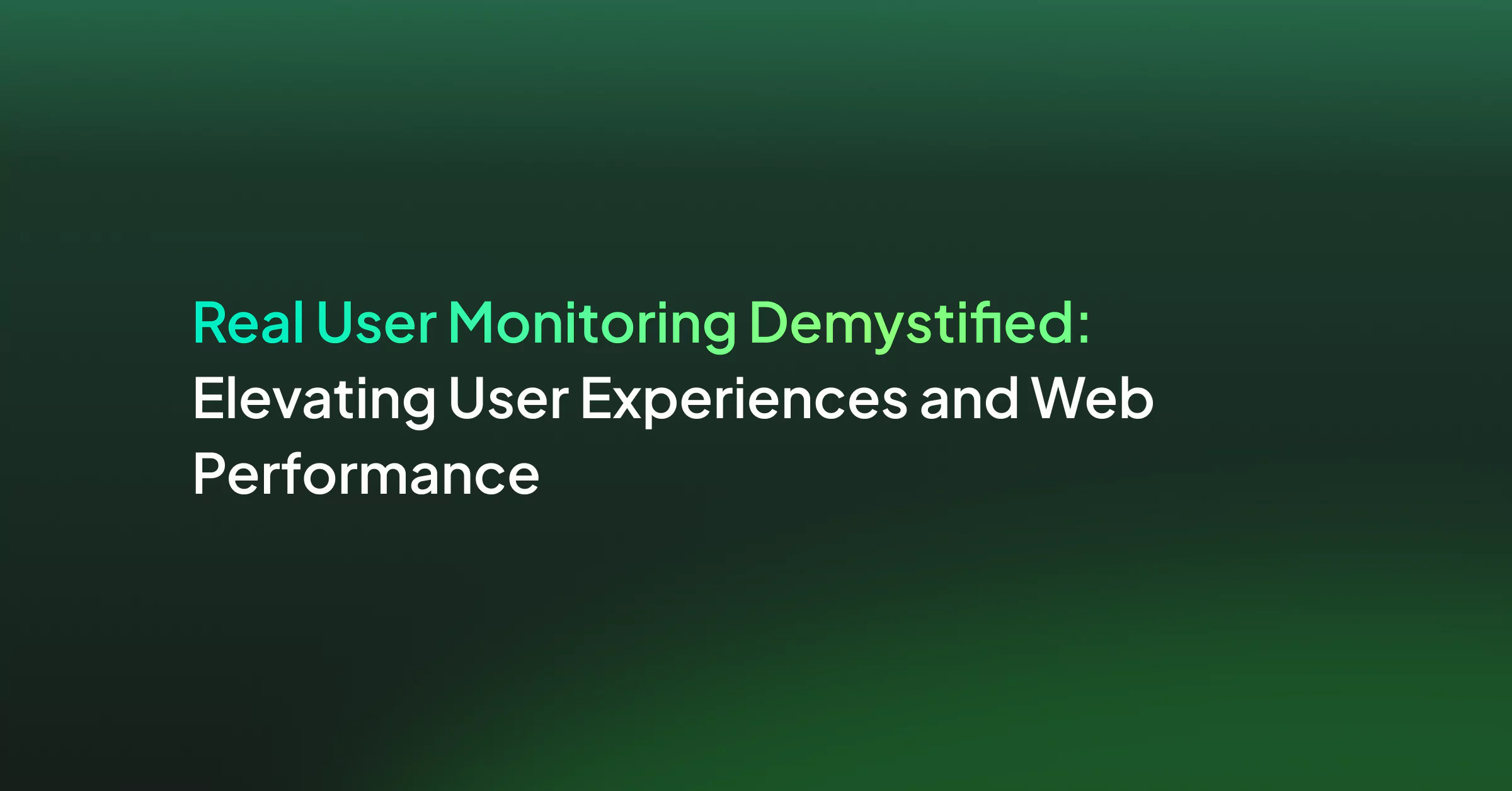Real User Monitoring Demystified: Elevating User Experiences and Web Performance

With constantly decreasing user attention spans, ensuring a seamless user experience has become a priority for all digital businesses. Users who encounter minimal application disruptions and responsive interactions will likely stay engaged and loyal to your product. And that’s exactly what RUM or Real User Monitoring tools such as Coralogix’s RUM solution offer. These tools such as error tracking and user sessions give you deep visibility into your system’s performance based on real user interactions.
This article will delve into the intricacies of Real User Monitoring, explaining its functionality, benefits, and key differences from synthetic monitoring.
What is real user monitoring?
Real User Monitoring collects data directly from users as they use the applications and allows developers to gain insights into the user journey. This data allows you to spot performance bottlenecks, understand user behavior, and the ability to optimize your platform based on real-world usage.
Some data metrics and events that real user monitoring captures include Mobile device specs, Browser & version, User Location, Page Rendering Time, Network Latency, TCP Connect time, First-byte Transmission, etc.
How does real user monitoring work?
Real User Monitoring typically involves integrating light-weight code into one’s frontend in order to detect and capture errors that arise within users’ browsers.
As users navigate your application, this code collects valuable performance data on their interactions. This data includes page load times, network latency, server response times, and user interaction events. This information is added to a central server and translated into actionable insights and visualization for decision-making.
Real User Monitoring solutions often anonymize and aggregate the data for a representative sample. This means that while individual user data remains private, developers can still gain insights into the overall performance trends and patterns.
Benefits of real user monitoring
Real user monitoring brings multiple benefits: accurate user-centric insights, enhanced user experiences, and the ability to make informed decisions.
Continuous Monitoring
Real User Monitoring helps you monitor your website/app and its performance. By constantly tracking user interactions and performance metrics, RUM offers real-time insights into the health of your platform. This continuous monitoring allows developers to stay proactive in identifying and addressing issues before they escalate and affect the user experience.
Accurate User-Centric Insights
RUM shifts the spotlight onto your users and sheds light on their behaviors, preferences, and pain points. By capturing data directly from real users, you gain a clear and holistic view of how real users interact with your website or application. These user-centric insights help you identify major pain points and tailor your development strategies to meet user needs.
Business Impact Analysis
Translating technical performance to business outcomes has always been a challenge. RUM helps managers bridge the gap between website performance and business success by correlating performance data with key performance indicators (KPIs).
Instead of relying on manager and developer reports, stakeholders can easily make data-driven decisions that directly impact revenue, conversions, and overall business growth.
Enhanced User Experience
Integrating RUM helps you identify pain points, optimize page load times, and fine-tune user flows. Tools such as Coralogix Real User Monitoring allow you to prioritize enhancements that matter most to your audience, leading to higher engagement and customer satisfaction.
Performance Optimization
Just like CDN Monitoring Tools, real user monitoring tools enable developers to fine-tune their code, minimize latency, and optimize user flow. These tools pinpoint performance bottlenecks and provide key performance metrics such as: page load time, first contentful paint, page render time, server response time, geographic data, browser and device breakdown, session info, etc.
Using these metrics, developers can understand how users are affected and make optimizations to various aspects of the product.
Real user monitoring vs. synthetic monitoring
While both RUM and synthetic monitoring aim to improve web performance, they operate differently and serve distinct purposes. Let’s review the core differences between the two:
Realism.
The way each user navigates through your product varies significantly based on various factors such as user interest, location, user behavior, time of interaction, etc. Real User monitoring captures data from real user interactions, providing insights into user behavior.
On the other hand, synthetic monitoring uses automated interactions written by testers/developers in controlled environments, which might not accurately represent real-world usage.
Data Collection
Real user monitoring tools excel in collecting real-time data directly from users, offering a comprehensive and accurate perspective on performance. Furthermore, RUM tools provide options to create visual data reports such as charts, bars, and graphs. In contrast, synthetic monitoring generates data through scripted tests, which can lack the complexity of real interactions.
Variability
When different real users interact with your application, they have different experiences due to the diversity of devices, network conditions, and geographic locations. Real user monitoring reflects the genuine diversity of user experiences, whereas synthetic monitoring’s controlled environment might not adequately represent these variables.
Problem Detection
Synthetic and real user monitoring differ drastically in the problems they detect. Synthetic monitoring focuses on predefined scenarios and is better suited for identifying potential issues before they impact users.
However, to track unknown or unexpected problems, real user monitoring comes in handy. RUM excels at identifying real-time issues experienced by users, making it suitable for prompt issue resolution.
Comprehensive Insights
Real user monitoring focuses on providing in-depth insights into actual user behavior. These insights help developers understand how users navigate through their website or app. The key focus of synthetic monitoring, on the other hand, synthetic monitoring’s key focus is only to track technical performance metrics.
Real user monitoring examples:
Let’s review a few examples illustrating how real user monitoring can uncover valuable insights across diverse industries.
E-Commerce Platform
RUM can directly help e-commerce platforms troubleshoot their sales process. For instance, RUM data on user interactions can uncover if users abandoned shopping carts on specific product pages. This insight can help product teams dig deeper into the root cause, such as page loading times, and optimize it to make it user-friendly.
Healthcare Applications
Healthcare applications often have video consultations, which can cause crashes if it is not configured properly. Real user monitoring tools can help understand how smoothly video calls are running. You can also find out if the issue occurs with users on specific mobile devices and pinpoint compatibility issues.
Travel Booking Website
Travel booking websites can have revenue-generation issues because of the high-ticket nature of their product. Integrating RUM solutions within their application deck can help understand where users drop off. For instance, users can drop off during the flight search process if search filters are slow to load. They can directly reduce bounce times by running a RUM check on all their applications for issues like these and delivering a premium experience.
News Website
News websites can use RUM to track user engagement on their articles. This data can help them analyze the load time of their articles, the articles that are driving the most users, and any performance issues. Using this data, news websites can optimize content delivery and page performance, leading to higher average session durations for their users.
Gaming Platform
Gameplay is the most critical aspect of a game. RUM data can help monitor user gameplay experiences, pinpoint specific issues during multiplayer matches, and help you fix them before your users complain.
Is real user monitoring for me?
If you run a digital application, RUM can drive business success by ensuring your applications deliver a premium user experience. Integrating Coralogix’s Real User Monitoring solution within your application stack can help you catch and fix bugs faster, directly translating to increased bottom-line revenue.




